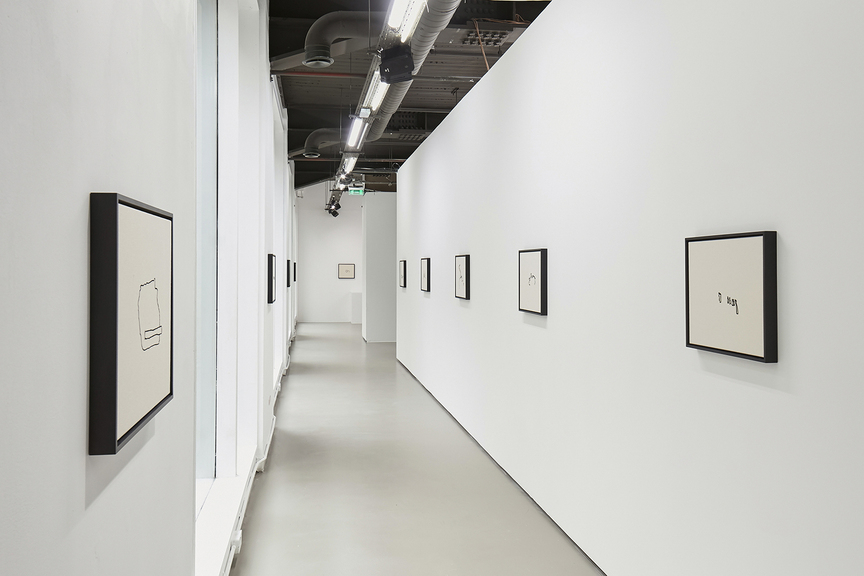-
From Current Issue
-
- Editor’s Letter Fire in the Heart
- Reviews I Gusti Ayu Kadek Murniasih
- Reviews 11th Seoul Mediacity Biennale: “One Escape at a Time”
- Dispatch Networked China
- One on One Monira Al Qadiri on Yukio Mishima
- Essays The rise of independent art spaces in pandemic-era Shanghai
- Features Tuan Andrew Nguyen
- Table of Contents
- Web Exclusives
- Archive
- Subscribe

R
E
V N
E
X
T
Installation view of YOUNG IN HONG‘s "The Moon’s Trick" at the Korean Cultural Centre, London, 2017. Photo by Luke Andrew Walker. Courtesy the artist and the Korean Cultural Centre.
Many things in art are matters of transposition. Figurative painting is a conversion of three dimensions into two, sculpture is in part the translation of a thing from one material to another, conceptual and performance art are about ideas manifested in matter and gesture. Through each of these transformations, some essence of the original subject remains, but information is inevitable lost and gained as a function of the media used. In the case of Young In Hong, who held her first solo exhibition, “The Moon’s Trick,” at a British public institution at the Korean Cultural Centre UK, the prominent use of embroidery in her practice brings much to her subjects as they are transformed into works of art.
Representative of much of the work from Hong’s ten-year career, several of the older pieces on display were based on photographs, and were particularly marked by the intensity of labor that went into their creation. Burning Love (2014), composed of viscose rayon threads and cotton, is a meticulously embroidered image in oversaturated blue, orange, yellow and red portraying the crowd from a candlelit demonstration held in Seoul in 2008, where participants are marked by thousands of dots of light. The manifestation was in response to a government decision to reverse a ban on US beef imports, and represented one of the most important democratic events in Korea’s modern history, seeing thousands take to the streets. It was notoriously underreported in mainstream media at the time, with little energy spent to document it, and so there is something poetic about the extraordinary amount of work that has gone into consolidating the moment here.
What the transposition into Hong’s media of choice subtracts in terms of documentary photorealism, it adds manifold in material significance. Embroidered images of flames, and the idea of a single moment given weight by the labor that goes into its representation, were also prominent in Shadow of Us (2016)—depicting candles left on the street in paper cups during another protest from 2013—and Burning With Triadic Harmony (2016)—in which silhouetted figures encircle a roaring fire of burning daljip (brushwood), representing an old Korean custom that celebrates the 15th day of the Lunar New Year. Below this second image, whose oversaturation means that the towering flame consists of just three predominant hues, is a simple set of white lines embroidered on black, representing the outlines of the three variously hot parts of the flame. This simplification, in conjunction with the suggestive but apt title, reduces the image to a ratio, and reveals an underlying harmony akin to that found in music, where three notes spaced at specific ratios harmonize to form a chord.
This kind of transposition—from an image to an underlying sonic implication—is where “The Moon’s Trick” came into its own. Collected under the title Prayers 1–40 (2017), throughout the exhibition were framed squares of cream-colored cotton on which are sewed minimalistic, linear forms in black—crude and almost cartoonish yet each carrying its own sense of harmony. Each of these “prayers” is a reduced pictorial fragment derived from archive photos of post-war South Korean cityscapes and the many protests that accompanied the country’s subsequent modernization, and they also represent what Hong calls “photo-scores.”
For the exhibition, these were interpreted into brief flurries of piano notes, played sporadically from speakers throughout the gallery to powerful effect. These transpositions are, of course, subjective—there is no universal rubric for translating an image into sound—but this made the installation into an insightful reflection on consciousness. Walking around Hong’s show, each “prayer” was like a mediating point between a visual input and a provocative output that surrounded visitors. The musical phrases slip in and out of recognizable scales and time signatures, evoking emotional responses, and yet our reactions to them cannot clearly be rationalized with regards to the original image from which the sounds are derived. In the transposition, as in our constant interpretations of events, information is gained and lost, moments are given weight they did not originally have, and the mind plays tricks.
Ned Carter Miles is the London desk editor of ArtAsiaPacific.
Young In Hong’s “The Moon’s Trick” is on view at the Korean Cultural Centre UK, London, until December 30, 2017.
To read more of ArtAsiaPacific’s articles, visit our Digital Library.







